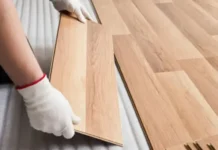Foundation cracks are a very serious problem. They can cause major structural damage to your home and should be fixed right away if you notice them. There are many different types of foundation cracks, and the best way to fix them will depend on which type they are. Read on to learn about these types of foundation cracks and the various ways of fixing cracked walls.
Slab Crack
A slab crack is one where there’s been movement in the concrete structure below the surface level because proper support wasn’t put into place or was lost over time due to shifting soil underneath it. To fix these sorts of foundational problems, make sure you use plenty of cement with stabilizing sand mixed in when filling the crack.
Misaligned Foundation Cracks
Misaligned foundation cracks happen when a home is built on sloping ground, which causes it to settle into an uneven position. These types of problems are typically fixed by adding fill dirt and leveling the surface with concrete or some other type of support material so your house will be straightened out again.
Hairline Cracks
At some point, the ground under your foundation will shift, and this can cause cracks in all sorts of different places. The most common type of crack is a hairline crack caused by movement happening underground. To fix these types of problems, you should use polyurethane sealant or concrete patching material on top, followed by another layer that matches the color of your house, so it blends in with the real estate around it.
Faulty Foundation Cracks
These are typically due to poor construction or damage from an event such as an earthquake. These issues need professional help unless you want everything else on top to fall too! But if fixing them yourself seems like something within reach, make sure you follow all directions carefully – new foundations can be very expensive to repair, so it’s better not to make a mistake.
Horizontal Cracks
Horizontal cracks are usually caused by various reasons, such as frost heave, external soil pressure, or just the pull from the ground pushing on the foundation. To fix these kinds of problems, you’ll need to have them reinforced with either steel beams in concrete slabs or horizontal cables in masonry walls. It’s important that whatever material you use can resist forces perpendicular and parallel to it for structural stability purposes!
Diagonal cracks
Diagonal cracks are caused by uneven settlement of the soil under your foundation. To fix this problem, you’ll need to make sure that there’s a barrier between the top and bottom layers of soil, so they don’t move around against each other as much. You might also want to consider pouring more concrete underneath for support purposes!
Non-Structural Foundation Crack
Non-structural foundation cracks are caused by water damage and can happen in all sorts of different places. These problems usually only need a simple fix to correct them, such as caulking around the crack or using waterproof sealant from inside your house, so you don’t have leaks anymore! In some cases, they might be fixed with insulation, or if the problem is bad enough, it might need to be rebuilt.
Structural Foundation Crack
The structural foundation crack means there’s a major issue with your home, and it needs to be dealt with promptly. This can happen due to numerous reasons, such as improper drainage in slope-built homes or foundations that aren’t properly reinforced when they’re being built. If you have this kind of problem, make sure you call a professional right away and be prepared to shell out some serious cash to fix it!
Shrinkage Crack
Shrinkage cracks happen when the soil under your home shrinks and the surface of it expands. These types of problems usually don’t need any major work done to fix them. Just make sure you fill in all gaps or holes created from this process with latex caulk so water won’t seep through anymore!
Wet Non-Structural Foundation Crack
Wet non-structural foundation cracks are caused by a power outage and usually only need to be dealt with immediately if they’re within three feet of the house. This is because water can get inside your walls, which could cause them to collapse from the pressure! To fix these problems, you’ll want to have an electrician check for any power outages nearby and make sure all the power is turned back on. You’ll also need to have a plumber come by as well so they can find any leaks outside your house and fix them quickly!
When it comes to foundation problems, there are many different types you may find yourself dealing with. What’s most important is that whatever type they are, you take care of them as soon as possible, so they don’t escalate into something bigger!



































































